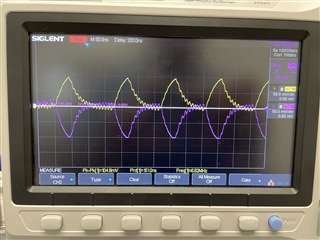Other Parts Discussed in Thread: ALP, USB2ANY
Hello all,
I have been using DS90UB947TRGCRQ1 with DS90UB948-Q1 custom made boards. There were issues getting this combination to work so I attempted using patgen to create a screen image. The backlight is on but no image is showing up.
The display parameter is as follows:
display-timings { lvds1_timing_cct2nd12p3: CCT2nd12p3{ /*CCT 2nd 12.3" */ clock-frequency = <88000000>; pixelclk-active = <0>; de-active = <1>; hsync-active = <0>; vsync-active = <0>; hactive = <1920>; vactive = <720>; hback-porch = <16>; hfront-porch = <38>; vback-porch = <5>; vfront-porch = <8>; hsync-len = <12>; vsync-len = <3>; };
The code for pat gen:
#/bin/bash
declare -a address=(0x63 0x66 0x67 0x66 0x67 0x66 0x67 0x66 0x67 0x66 0x67 0x66 0x67 0x66 0x67 0x66 0x67 0x66 0x67 0x66 0x67 0x66 0x67 0x66 0x67 0x65 0x64)
declare -a __write=(0x01 0x03 0x02 0x07 0x80 0x08 0x07 0x09 0x2D0 0x04 0x80 0x05 0x07 0x06 0x2D0 0x0C 0x10 0x0D 0x05 0x0A 0x0C 0x0B 0x03 0x0E 0x03 0x03 0x31)
# get length of an array
length=${#address[@]}
# use C style for loop syntax to read all values and indexes
for (( j=0; j<length; j++ ));
do
# printf "Current index %d with value %s\n" $j "${address[$j]}"
# printf "Current index %d with value %s\n" $j "${write[$j]}"
printf "i2cset -y 0x2 0x2c %d %s \n" "${address[$j]}" "${__write[$j]}"
i2cset -y 0x2 0x2c ${address[$j]} ${__write[$j]}
done
With using the patgen. The only difference I am seeing is the lock status pulling high with the internal clock being used.
Any feedback or solutions will be very appreciated. Thanks!


